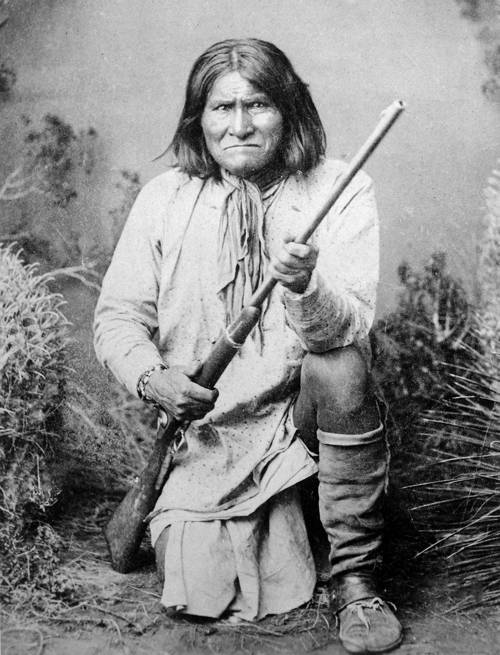
FAQ About Geronimo

Who was Geronimo?
Geronimo was a prominent leader and medicine man of the Apache tribe, known for his resistance against Mexico and the United States' military incursions. His real name was Goyahkla, meaning 'the one who yawns.'

What tribe did Geronimo belong to?
Geronimo belonged to the Bedonkohe band of the Chiricahua Apache tribe. The Apache people are a group of culturally related Native American tribes in the Southwestern United States.

Why is Geronimo considered a symbol of Native American resistance?
Geronimo is considered a symbol of Native American resistance because of his persistent efforts to defend Apache lands against Mexican and U.S. expansion. His guerrilla warfare tactics and his refusal to surrender made him a powerful icon of resistance and resilience for his people.

What were some of Geronimo's major campaigns against the U.S. military?
Geronimo led numerous raids against both Mexican and American settlements. Some of his major campaigns include the battles and raids throughout the 1880s, which disrupted American expansion into Apache territories in the American Southwest.

When was Geronimo born?
Geronimo was born in June 1829, near the Gila River, which is located in modern-day New Mexico.

How did Geronimo get his name?
Geronimo was given the nickname by Mexican soldiers who encountered him in battle. While the exact reason is unclear, it’s commonly believed that they either mispronounced his given name or were invoking Saint Jerome (San Geronimo) for protection during skirmishes with him.

What impact did Geronimo have on Apache history?
Geronimo had a significant impact on Apache history as he became a symbol of resistance and bravery. His defiance against colonization is remembered as a major chapter in the Apache struggle to maintain their lands and cultural identity.

How did Geronimo's resistance efforts come to an end?
Geronimo's resistance efforts ended when he surrendered for the last time to U.S. General Nelson Miles in 1886. He was taken as a prisoner and exiled to Florida, eventually settling in a reservation in Oklahoma, where he lived until his death.

Where did Geronimo die, and when?
Geronimo died of pneumonia on February 17, 1909, at Fort Sill in the Indian Territory, which is now part of Oklahoma.

Why did Geronimo surrender?
Geronimo surrendered because of relentless pursuit by U.S. troops and the hope for better treatment for himself and his followers. Continuous raids and poor conditions in hiding forced him to capitulate after evading capture for many years.

What is a common misconception about Geronimo?
A common misconception about Geronimo is that he was a chief. Although a recognized leader and warrior, Geronimo was never a chief of the Apache tribe but was a revered medicine man and war leader.

What happened to Geronimo after his surrender?
After surrendering, Geronimo was held as a prisoner of war and was relocated multiple times, ending up at Fort Sill, Oklahoma. Despite his status as a prisoner, he became a celebrity of sorts and participated in events like the 1904 World's Fair and President Theodore Roosevelt’s inaugural parade in 1905.

Did Geronimo ever escape from capture?
Yes, Geronimo escaped capture multiple times during his campaigns. His most notable escape was in 1885 when he fled with a group of followers from their reservation, leading to an extended guerilla campaign against U.S. forces.

What role did Geronimo play in Apache culture?
Geronimo played an important role in Apache culture as a spiritual and military leader. His stories of resistance and survival have been passed down as part of the Apache oral tradition, galvanizing his image as a hero and a protector of his people.

What is the historical significance of Geronimo's surrender?
Geronimo's surrender marked the end of the Indian Wars in the United States, effectively concluding active Native American military resistance in the Southwest. It symbolized the end of an era of fierce indigenous defense against colonization.

How did Geronimo contribute to American history?
Geronimo contributed to American history by epitomizing the struggle of Native Americans against U.S. expansion. He brought national attention to the plight of his people and continued to influence dialogues about Native American rights and identity long after his death.

How is Geronimo remembered today?
Today, Geronimo is remembered as a symbol of resistance and courage. His legacy is commemorated in various memorials and cultural references, and he is celebrated for his enduring spirit and leadership in the face of adversity.

What personal characteristics was Geronimo known for?
Geronimo was known for his extraordinary bravery, tactical shrewdness, and leadership abilities. He inspired loyalty and respect among his followers and was especially revered for his resilience both in and out of battle.

Are there any books about Geronimo?
Yes, many books have been written about Geronimo. One of the most notable is his autobiography, "Geronimo's Story of His Life," as told to S.M. Barrett, which offers personal insights into his life and struggles.

What was Geronimo's role in the Apache Wars?
Geronimo played a crucial role as a leader during the Apache Wars, a series of conflicts between the Apache and the United States from the mid-19th century to the early 20th century. He led raids and defense against the encroaching forces, becoming one of the most formidable opponents.
